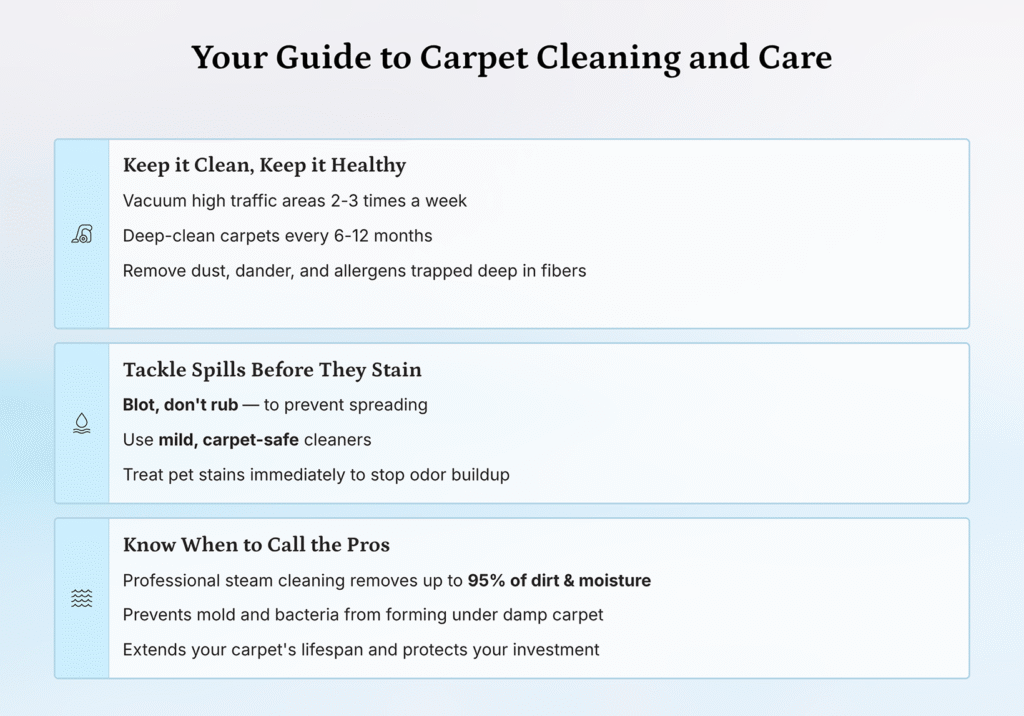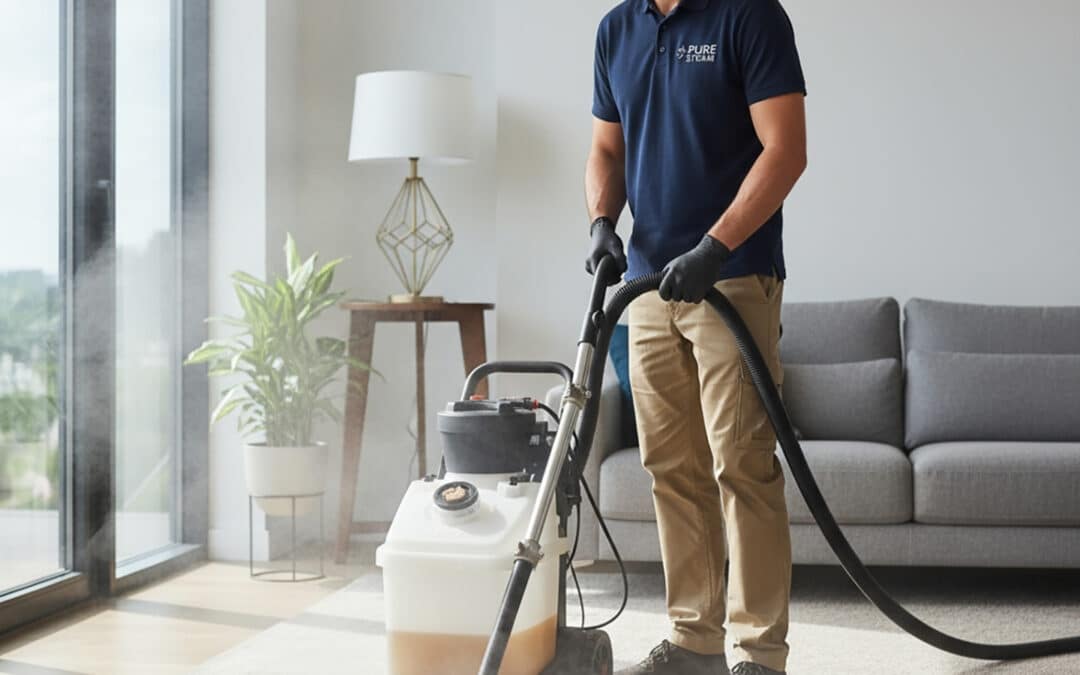🧠 Key Points on Carpet Cleaning and Care
- Carpets act like filters — trapping dust, allergens, and pollutants that would otherwise circulate through the air.
- Regular cleaning matters — carpets stop filtering effectively once saturated, and pollutants can re-enter the air.
- Hot water extraction is the gold standard for deep cleaning; it removes bacteria, allergens, and residue more effectively than other methods.
- EPA and IICRC guidelines recommend professional cleaning every 6–12 months, or more often, for homes with pets, children, or allergies.
- DIY cleaning is fine for small stains or touch-ups, but can’t match the heat, suction, or thoroughness of professional systems.
- Professional carpet cleaning improves indoor air quality, reduces allergens, and supports a healthier home environment.
- Proper drying after cleaning prevents mold and mildew, especially in humid conditions.
- Routine care — vacuuming, spot-cleaning spills quickly, removing shoes, and using protectors — extends carpet life.
- Well-maintained carpets enhance home comfort, protect your investment, and contribute to overall wellness.
Your carpets do more than just tie a room together — they act as filters for your home, trapping dust, allergens, pet dander, and everyday dirt that would otherwise circulate through the air your family breathes. But like any filter, carpets need regular cleaning to keep doing their job effectively.
At Easy Clean Carpet Care, we’ve spent over 35 years helping families maintain healthier, fresher homes through professional carpet cleaning and expert care advice. Whether you’re dealing with stubborn pet stains, concerned about indoor air quality, or wondering if it’s time for a deep clean, this guide covers everything you need to know about keeping your carpets in top condition.
We also created a carpet care guide just for families who deal with spills, pets, and everyday messes.
What Is Carpet Cleaning and Why Does It Matter
Carpet cleaning goes beyond what your vacuum can reach. While regular vacuuming removes surface dirt and debris, professional carpet cleaning tackles the deep-down grime, bacteria, and allergens embedded in carpet fibers over time.
Carpets can temporarily improve indoor air quality by trapping particulates that would otherwise circulate through your home. However, those same pollutants can re-enter the air without regular maintenance through foot traffic or vacuuming — according to the American Lung Association, the EPA, and NIH research.
Common Carpet Cleaning Methods Explained
Not all carpet cleaning methods are created equal. Understanding the differences helps you make informed decisions about what’s best for your home.
Hot Water Extraction (Steam Cleaning)
This is the gold standard for deep cleaning and the method most commonly used by professionals.
It involves injecting hot water and cleaning solution deep into carpet fibers (typically above 140 °F) and immediately extracting the solution along with dissolved dirt, allergens, and bacteria. Despite the name “steam cleaning,” it actually uses hot water rather than steam.
According to the IICRC S100 Cleaning Standard and Angi’s guide to cleaning methods, this process removes more contaminants than other methods and minimizes residue buildup.
Carpet Shampooing
An older technique uses a foaming cleaner and rotating brushes. It can brighten carpets but often leaves residue that quickly attracts new dirt.
Dry Cleaning
Dry cleaning uses specialized compounds or low-moisture solutions that allow immediate use. It is best for light maintenance, not deep cleaning.
Encapsulation Cleaning
It applies polymers that crystallize dirt particles as they dry. This is effective for surface refreshes and commercial spaces with minimal downtime.
How Often Should You Clean Your Carpets?
One of the most common questions we hear is, “How often should I really be cleaning my carpets?”
The EPA does not set official cleaning intervals but advises homeowners to follow manufacturer and IICRC standards — typically every 6 to 12 months. More frequent cleanings are recommended if you have pets, kids, or allergy concerns.
- Every 6 – 12 months for average households
- Every 3 – 6 months for homes with children or pets
- Every 2 – 3 months for allergy-sensitive households
- After large gatherings, renovations, or spills
Wondering how often you should schedule carpet cleaning? Our detailed guide breaks down the ideal timetable based on pets, kids, allergies, and traffic: Carpet Cleaning: How Often Should You Clean Your Carpet?
Looking for seasonal cleaning advice? Visit our new Holiday Carpet Cleaning post to learn how to prepare your carpets for the busy holiday season and keep them spotless for guests.
DIY vs. Professional Carpet Cleaning
When DIY Makes Sense
DIY machines can refresh small areas between professional visits. They’re best for spot-cleaning or short-term upkeep.
When Professional Cleaning Is Worth It
Professional systems heat water above 60 °C and use powerful suction to efficiently remove moisture and allergens. Industry experts at the IICRC confirm that professional equipment achieves significantly deeper sanitization and faster drying than rental units.
To learn how professional carpet and upholstery cleaning work together to improve indoor air quality and extend furniture life, read our full guide — Carpet & Upholstery Cleaning: Your Guide to a Fresher, Healthier Home
How Carpet Cleaning Improves Indoor Air Quality
The indoor air in your home can be two to five times more polluted than outdoor air. Carpets trap airborne particles like dust, pollen, and pet dander, keeping them out of circulation — until saturation. Professional cleaning restores this filtering function.
Scientific reviews from NIH PubMed Central and the American Lung Association confirm that deep cleaning reduces allergens and bacteria, benefiting families with asthma or allergies.
Explore related topics in The Health Benefits of Professional Carpet Cleaning.

Mold, Mildew, and Moisture Control
Proper professional cleaning and thorough drying help prevent mold growth, especially in humid areas or after spills.
The EPA notes that carpets in damp environments should always be dried within 24–48 hours to prevent mildew.
Carpet Care Tips Between Professional Cleanings
- Vacuum Regularly — High-traffic areas twice weekly; other areas weekly.
- Address Spills Immediately — Blot, don’t rub.
- Use Doormats and Remove Shoes — Reduce tracked-in dirt by 80 %.
- Rearrange Furniture — Prevent premature wear patterns.
- Use Carpet Protectors — Consider stain-resistant treatments after professional cleaning.
- Handle Pet Accidents Properly — Use enzymatic cleaners; schedule periodic professional treatments.
When It’s Time to Deep Clean or Replace
Even with good maintenance, carpets have a lifespan.
Consider professional deep cleaning when you notice embedded dirt, persistent odors, or increased allergy symptoms.
Replacement may be needed if backing deteriorates, odors persist, or carpets are 10–15 years old.
Experience the Easy Clean Difference
Your carpets play a vital role in your home’s comfort and health. With 35 years of experience, Easy Clean Carpet Care combines proven cleaning methods with genuine care for every home we enter.
Ready to experience the difference that truly clean carpets make?
Visit our Carpet Cleaning Services page or Contact Us to schedule your professional cleaning today.
Your family deserves to live in a clean, healthy home — let us help you make that happen, one carpet at a time.
❓ Frequently Asked Questions About Carpet Cleaning
1. How often should I have my carpets professionally cleaned?
Most homes benefit from professional carpet cleaning every 6–12 months. If you have pets, children, or allergy concerns, aim for every 3–6 months to keep your carpets fresh and your indoor air cleaner.
2. What’s the best method for deep carpet cleaning?
Hot water extraction (often called steam cleaning) is the industry standard. It uses high-temperature water—around 140°F—and powerful suction to remove dirt, allergens, and bacteria trapped deep in carpet fibers.
3. Can carpet cleaning help with allergies or asthma?
Yes. Professional cleaning removes dust mites, pet dander, and pollen that can trigger allergies or asthma. Clean carpets help improve indoor air quality, especially for families with children or sensitive respiratory systems.
4. Is DIY carpet cleaning as effective as professional service?
DIY machines are fine for light refreshes or spot cleaning, but they typically lack the heat and suction power to sanitize deeply. Professional carpet cleaning offers stronger extraction, shorter drying times, and longer-lasting results.
5. How long does it take for carpets to dry after cleaning?
Most carpets dry within 6–12 hours, depending on humidity, airflow, and carpet thickness. Turning on ceiling fans and opening windows can speed up the process.
6. How can I make my carpets last longer between cleanings?
Vacuum at least once weekly, treat spills immediately, and remove shoes indoors. Using doormats and applying carpet protectors after cleaning can also help prevent wear and stains.
📚 Additional Resources
- American Lung Association – Carpets and Health
- EPA– Carpets and IAQ in Schools
- NIH – Do Carpets Impair Indoor Air Quality?
- EPA – Carpet Cleaning Frequency Guidance
- IICRC – S100 Cleaning Standard


Recent Comments